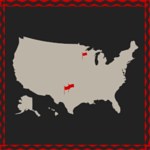Wind turbines interfere with airport and military radar systems so various companies are trying to fix the problem. There are at least 50 mitigation solutions that have reared their head at some point in the past ten years.
Mitigation
The most common forms of mitigation which are considered are: Radar blanking; Radar upgrade; Wind farm design and Radar In-Fill. Radar In-Fill solutions work by replacing data from the affected radar with data from an unaffected radar. In some cases the unaffected radar is a conventional radar that won’t see the turbines or it can be a radar that won’t be affected by the turbine.
![]() There are a number of radar mitigation solutions that can be considered for wind farms including:
There are a number of radar mitigation solutions that can be considered for wind farms including:
- Aveillant 3D Holographic Radar™
- C Speed LightWave radar
- Raytheon/NATS Project RM
- Terma Scanter 4002
- Cyrrus Smartener
- Thruput MIDAS II
- Thales STAR 2000
Aveillant
Aveillant’s 3D Holographic Radar is an in-fill radar that is designed not to be affected by wind turbines. In this article we will consider:
- Practical issues associated with implementing Aveillant mitigation
- How the Aveillant 3D Holographic Radar differs from a conventional radar
- How the radar performed in US military trials designed to compare wind turbine mitigation radar

Radar Siting
Conventional radar are typically installed at airports or on the tops of hills that have a good 360 degree view of the sky. The cheapest form of the Aveillant solution has limited range (compared to more expensive versions) and 90 degrees of coverage meaning that it is best located just beyond a wind farm’s boundary to give optimal coverage around the wind farm.
The new radar will need robust and secure siting, electricity supply and data communications services to ensure its integrity matches that of the radar system being mitigated.
Conventional 2D Vs Aveillant 3D
The main differences between an Aveillant 3D radar and a conventional 2D radar (e.g. cSpeed and Terma) are shown in the table below:
| Parameter | Conventional 2D | Aveillant 3D |
| Coverage | Symmetrical coverage through 360 degrees. | Assymetric coverage with 90 degree sensor. Symmetrical coverage with 4 sensors combined. (90-360 degrees) |
| Movement | Rotates through 360 degrees | Solid State |
| Update Rate | Updates typically every 4 seconds based on rotation | Update frequency selectable and can be synchronized with radar being mitigated. (Reporting interval 0.25 to 1 sec) |
| Slant Range Error | Slant Range Errors occur unless mitigating radar is sited near radar being mitigated | Slant Range Errors are eliminated by 3D data processing |
| Physical Implementation | Larger rotating sensor | Smaller fixed sensor |

US Trial
In July 2014 the US government publicised the results [1] of government trials comparing the performance of various wind farm mitigation technologies.
It published graphs comparing the technologies for flights above wind farms and also flights away from wind farms.
The two specific measures related to detection of genuine aircraft as well as the likelihood of displaying false returns. An inspection of the published results suggests that the Aveillant sensor is the best performer (not quite perfect) both in the presence and absence of wind turbines.
Sensor Performance
Aveillant publishes the following technical data:
| Attribute | Specification |
| Range | 40 Nautical Miles |
| Altitude | More than 60,000 feet |
| Probability of Detection | >96% |
| False Alerts | Less than 1 per hour per 10 km2 |
Summary
The main disadvantages are the potential requirement to host radar equipment on a new site and the fact that the system has no operational track record. Key advantages of the Aveillant solution are ease of integration and the excellent technical performance demonstrated in the US Government trials.
Sources
[1] “Summary of Test Results for the Interagency Field Test &Evaluation of Wind Turbine – Radar Interference Mitigation Technologies PUBLIC RELEASE” by U.S. Department of Defense, U.S. Department of Homeland Security, Federal Aviation Administration and U.S. Department of Energy. Publicly published July 9th 2014. Last Accessed 23/12/2014.
